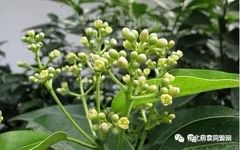
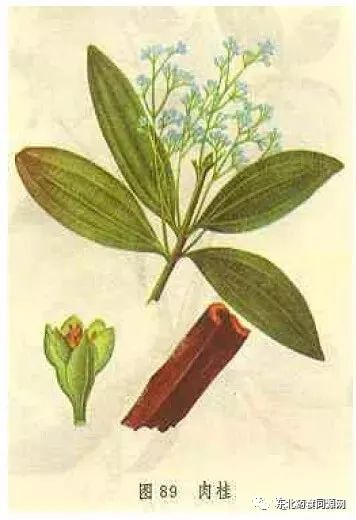
Medicinal Material Name: 肉桂 (Ròuguì – Cinnamon)
Alias: 菌桂 (Jūnguì – Fungal Cinnamon)
Harvesting and Processing: Harvested mainly in autumn, dried in the shade.
Medicinal Part: Bark
Origin: Guangxi, Guangdong
Family: Lauraceae
Source Plant: 肉桂 (Ròuguì – Cinnamon)
Plant Description: Evergreen tree, height 12-17 meters. Bark is gray-brown, aromatic, and young branches are slightly quadrangular.
Leaves are alternate, leathery; elongated oval to nearly lanceolate, 8-17 cm long, 3.5-6 cm wide, with a pointed tip and blunt base, entire margin, green and glossy above, gray-green and covered with fine hairs below; with three prominent veins near the base, fine veins parallel; petiole robust, 1-2 cm long.
Inflorescence is axillary or near the apex, 10-19 cm long, covered with short fine hairs; flowers small, about 3 cm in diameter; pedicel about 5 mm long; flower tube about 2 mm long, with 6 lobes, yellow-green, oval, about 3 mm long, densely covered with short fine hairs inside and outside; 9 stamens in 3 whorls, anthers are oblong, 4-locular, lobes split, the outer two whorls of filaments without glands, the third whorl of stamens facing outward, with 2 glands at the base of the filaments, and one whorl of degenerated stamens inside, anthers heart-shaped; the pistil is slightly shorter than the stamens, ovary oval, 1-celled, with 1 ovule, style slender, nearly equal in length to the ovary, stigma slightly disc-shaped. Flowering period is from May to July.
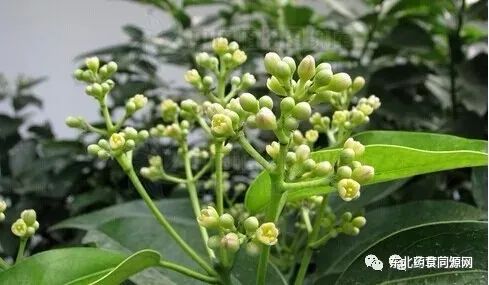
Fruits are oval or obovate, slightly flattened at the tip, dark purple, about 12-13 mm long, with persistent flower remains. Seeds are long oval, purple. Fruit ripens until February to March of the following year.
Characteristics of Cinnamon Medicinal Material: This product is in a groove or rolled shape, 30-40 cm long, 3-10 cm wide or in diameter, 0.2-0.8 cm thick. The outer surface is gray-brown, slightly rough, with irregular fine wrinkles and transverse raised pores, some may show gray-white spots; the inner surface is reddish-brown, slightly flat, with fine longitudinal lines, and shows oily marks when scratched. It is hard and brittle, easily broken, with an uneven fracture surface, the outer layer is brown and rough, while the inner layer is reddish-brown and oily, with a yellow-brown line between the two layers. The aroma is strong, with a sweet and spicy taste.
桂通 (Guāntōng – Official Cinnamon): Obtained from the dry bark of 5-6 year old young trees or the bark of old tree branches, not pressed, naturally rolled into a tubular shape.
企边桂 (Qìbiān Guì – Edge Cinnamon): Obtained from the dry bark of trees over 10 years old, with both ends cut at an angle to expose the cinnamon heart, placed between wooden uneven boards, pressed into a shallow groove shape with both sides curling inward.
图片板桂 (Túpiàn Bǎn Guì – Picture Board Cinnamon): Obtained from the dry bark near the ground of old trees, placed in wooden clamps, dried until 90% dry, stacked and pressed for about 1 month until completely dry, becoming flat and board-like. Shows oily marks when scratched. It is hard and brittle, easily broken, with an uneven fracture surface, the outer layer is brown and rough, while the inner layer is reddish-brown and oily, with a yellow-brown line between the two layers.
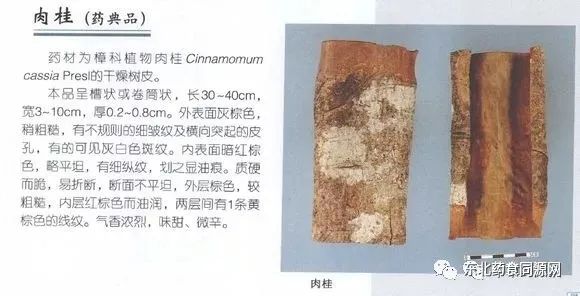
The best quality medicinal material is unbroken, heavy, with fine outer skin, thick flesh, purple fracture surface, high oil content, strong aroma, sweet and spicy taste, and little residue when chewed. The sweeter and spicier, the better. The best quality is characterized by fine skin, thick flesh, purple-red fracture surface, high oil content, strong aroma, sweet and spicy taste, and little residue when chewed.
Properties of Cinnamon:
【Shennong’s Classic of Materia Medica】 states: 菌桂 (Jūnguì – Fungal Cinnamon) has a spicy and warm taste. It is used for various diseases, nourishes the spirit, harmonizes colors, and is the first among all medicines. Long-term use can lighten the body and prevent aging, making the face radiant and youthful.
It has a sweet and spicy taste, aromatic fragrance, and warm nature, entering the 足厥阴肝经 (Zú Juéyīn Gān jīng – Foot Jueyin Liver Meridian). It warms the liver and blood, breaks blood stasis, dispels dampness and cold from the waist and legs, and alleviates abdominal and lateral pain.
The liver belongs to wood and stores blood, and blood carries the energy of wood, which is warm in nature. Warm energy rises to the left, and yang harmonizes and spreads; when accumulated, it generates heat, transforming into heart fire. The warmth of wood is half-rising yang, and the heat of fire is fully floating yang. People know that energy is yang, but do not realize it contains yin essence; they know blood is yin, but do not realize it contains yang energy. The warmth in blood is the source of heat transformation; when warm energy is sufficient, yang is strong, and the person is healthy; when warm energy is weak, yin is strong, and the person is ill. When yang returns, life is generated; when yin prevails, death occurs. Life and death, beauty and ugliness are different; yang and yin, nobility and lowliness are also different. The movement of insects is known to all, but the nobility and lowliness of yin and yang are not understood by the common people, leading to the source of calamity throughout the ages, arising from the family that values yin and despises yang.
To seek longevity, one must support yang energy. The method to support yang is to cultivate it within essence and blood, nurturing its root. If the root of yang is weak, there is only deficiency in the water and wood of the fetus, and there is no excess; there are no cases of excessive warm energy causing illness. The liver’s heat disease arises from insufficient vitality, warm energy being depressed, and generating wind dryness, not from strong yang and weak yin.
肉桂 (Ròuguì – Cinnamon) warms and smooths, replenishing the warm energy in the blood. The fragrant sweetness enters the earth, while the spicy sweetness enters the wood; the spicy and fragrant energy is good at resolving stagnation, thus it is best at relieving liver and gallbladder depression.
The taste of metal is spicy, and the taste of wood is sour; spicy and sour are the stagnation of metal and wood, leading to lung and liver diseases. The nature of metal is to gather, while the nature of wood is to disperse. Metal is said to follow the skin; when it gathers, it does not follow, thus it becomes spicy. Wood is said to be straight and curved; when it is straight, it disperses, and when it is curved, it does not disperse, thus it becomes sour. Spicy leads to lung disease, while sour leads to liver disease due to stagnation; therefore, the lung benefits from sourness, and the liver benefits from spiciness. When the lung receives sourness, it follows the descent, and the spicy taste gathers; when the liver receives spiciness, it rises, and the sour taste disperses. There are opposites that complement each other; this is the case. The liver and spleen relax, warm energy rises and transforms into yang spirit; the yang spirit commands, and yin evil has no power, thus the path to prolonging life is nothing but this.
All syndromes of meridian obstruction, organ blockages, joint stiffness, and abdominal pain are due to the decline of warm energy and coldness in the blood. This leads to leakage from above and below, the nine orifices not being guarded, purple-black clots, and decay. Women’s menstrual and postpartum diseases all fall under this category. All should use 肉桂 (Ròuguì – Cinnamon), as other medicines cannot.
肉桂 (Ròuguì – Cinnamon) is tree bark, also primarily acting on the exterior, but it is heavy and thick, thus it acts internally within the exterior. Its strength reaches directly to the organs, differing from 桂枝 (Guìzhī – Cinnamon Twig) which primarily acts on the meridians.
Remove the bark for use.
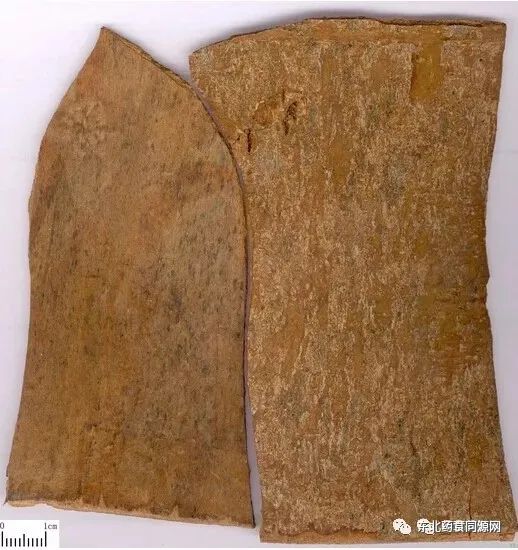
【Origin】 Produced in Annam and regions such as Yunnan and Guangdong in China, the tree is tall, and the bark is used in medicine.
【Properties and Taste】 Spicy and sweet, very hot, with slight toxicity.
【Indications】 肉桂 (Ròuguì – Cinnamon) is a key warming and tonifying medicine, primarily used to support fire and assist yang, warm the middle and dispel cold, can guide fire back to the source, treat upper heat and lower cold, break through deep cold and stubborn cold, treat cholera and cramps, and alleviate various abdominal pains and hernias.
【Ancient Texts】 Tonifies the kidney gate deficiency, can benefit fire and eliminate yin.
【Elements】 Tonifies the lower jiao deficiency, treats deep cold and stubborn cold diseases, dispels wind-cold from the exterior, treats spontaneous sweating due to exterior deficiency, contraindicated in spring and summer, and for lower abdominal pain in autumn and winter. Without this, it cannot be stopped.
【Wang Ang】 Wood becomes dry with cinnamon, and it can also suppress liver wind and support spleen earth, treating spleen deficiency with poor appetite and dampness leading to diarrhea, tonifying labor and unblocking the meridians.
【Ling Tai】 Tonifies yang energy and expels yin evil. 【Dosage】 Generally 3-9 grams.
【Contraindications】 Avoid raw scallions, resin, and fire roasting; use cautiously in cases of yin deficiency with internal heat. In cases of dry mouth and little liquid, use cautiously; for poisoning from wood fruits or melons, and for poisoning from closed-mouth Sichuan pepper, using cinnamon decoction can resolve. 肉桂 (Ròuguì – Cinnamon) is generally used raw for greater potency.
It is the fire of the earth, entering the blood, but Zhang Zhongjing takes it for its qi transformation, not for blood transformation. 肉桂 (Ròuguì – Cinnamon) guides heart fire down to interact with water, requiring the addition of 附子 (Fùzǐ – Aconite) to invigorate kidney yang to stimulate its energy; this is the ability of 肉桂 (Ròuguì – Cinnamon) to transform qi, due to the presence of 附子 (Fùzǐ – Aconite).
【Processing】 Remove impurities, scrape off rough skin, and brush off dust to obtain. 肉桂 (Ròuguì – Cinnamon) is very spicy and very warm; although it has a metal taste, it is essentially of wood and fire nature, thus it primarily enters the heart and liver blood, assisting the source of blood transformation; cinnamon bark can also ascend. Zhang Zhongjing’s复脉汤 (Fùmài Tāng – Pulse Recovery Decoction) uses 桂枝 (Guìzhī – Cinnamon Twig) for its entry into the heart to assist fire and transform blood.
【Rong Chuan】 肉桂 (Ròuguì – Cinnamon) has a thicker taste than 桂枝 (Guìzhī – Cinnamon Twig) and a more concentrated aroma. It is the ultimate of wood; very spicy means very warm, can benefit heart fire, as it is a specialized medicine for generating fire from wood; in fact, it is a warming liver product. The liver is the mother of the heart; if it is deficient, it should be supplemented. Both heart and liver govern the blood, thus 肉桂 (Ròuguì – Cinnamon) is also a key medicine for warming blood. Zhang Zhongjing’s kidney qi pill connects the heart and liver fire to return to the kidney.
【Ni’s Note】 Generally, 桂枝 (Guìzhī – Cinnamon Twig) is often used for arterial circulation issues, capable of promoting yang and reaching the exterior.
【Appendix】 桂心 (Guìxīn – Cinnamon Heart) primarily tonifies yang, invigorates blood, treats all wind diseases, tonifies the five labor and seven injuries, opens the nine orifices, benefits joints, nourishes essence and brightens the eyes, warms the waist and knees, breaks phlegm and treats stubborn cold, dispels blood stasis, and treats wind bi and joint contraction, reconnects tendons and bones, and generates muscle.
【Ri Hua】 Treats nine types of heart pain, unbearable abdominal cold pain, cough with reversed qi and obstructed gas, numbness in the feet, stops diarrhea, kills three worms, treats nasal polyps, breaks blood and unblocks menstrual obstruction, and retains the placenta.
【Zhen Quan】 Guides blood to transform sweat and pus, internally expels abscesses, treats choking and fullness in the abdomen.
【Processing】 Remove impurities and rough skin. Crush before use.
【Properties and Taste】 Spicy, sweet, very hot.
【Meridian Entry】 Enters the kidney, spleen, heart, and liver meridians.
【Functions and Indications】 Tonifies fire, assists yang, disperses cold, stops pain, invigorates blood, and unblocks meridians. Used for impotence, cold in the uterus, cold pain in the waist and knees, kidney deficiency causing wheezing, yang deficiency dizziness, red eyes and sore throat, cold pain in the heart and abdomen, deficiency cold vomiting and diarrhea, cold hernia, and menstrual obstruction and dysmenorrhea.
【Dosage】 1-4.5 grams.
【Precautions】 Use cautiously in those with bleeding tendencies and pregnant women; not suitable for use with 赤石脂 (Chìshízhī – Red Resin).
【Storage】 Store in a cool, dry place, tightly sealed.

Use medication with caution, please follow medical advice! This article is compiled from the internet. If there is any infringement in the images and text, please contact the editor for deletion.

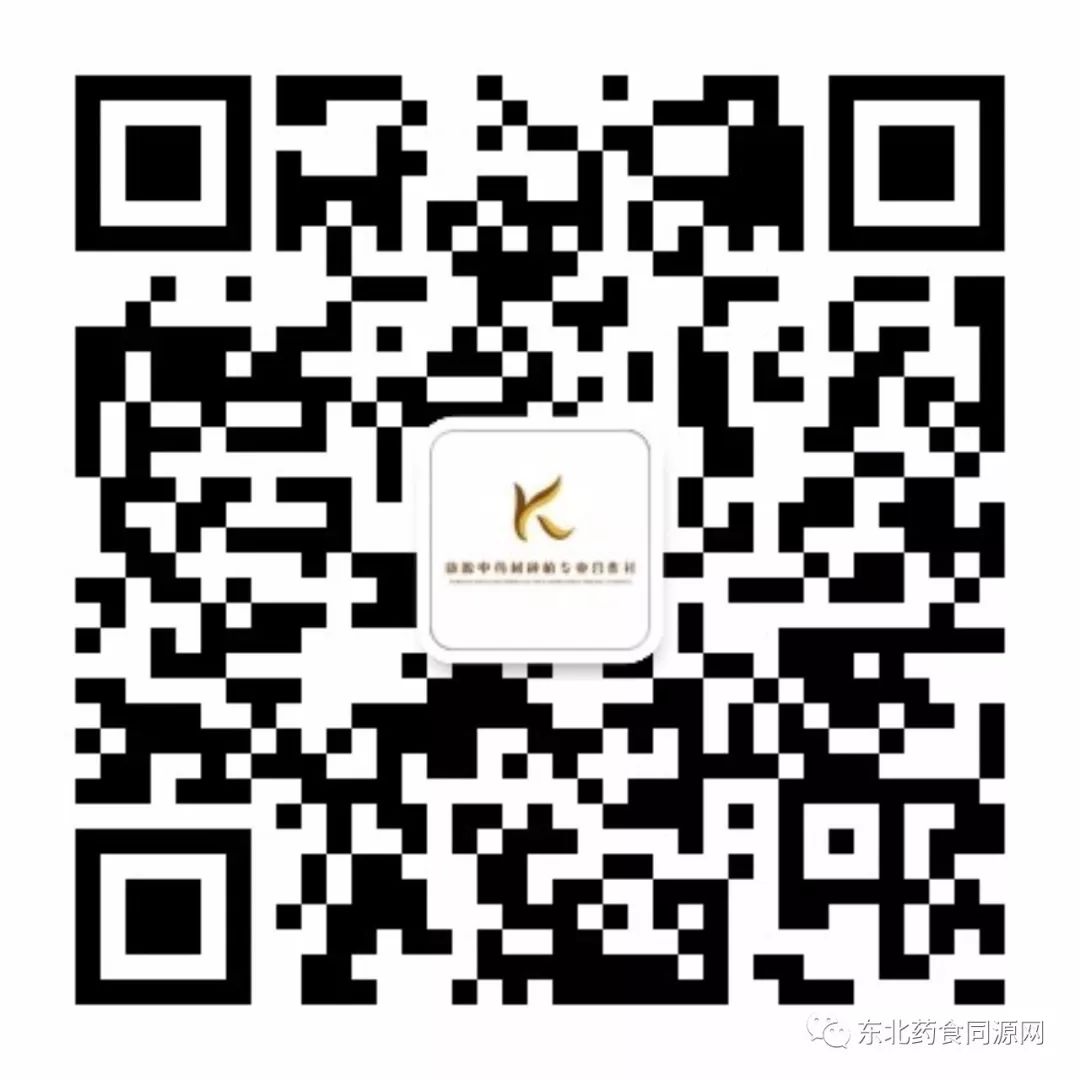

Follow us

